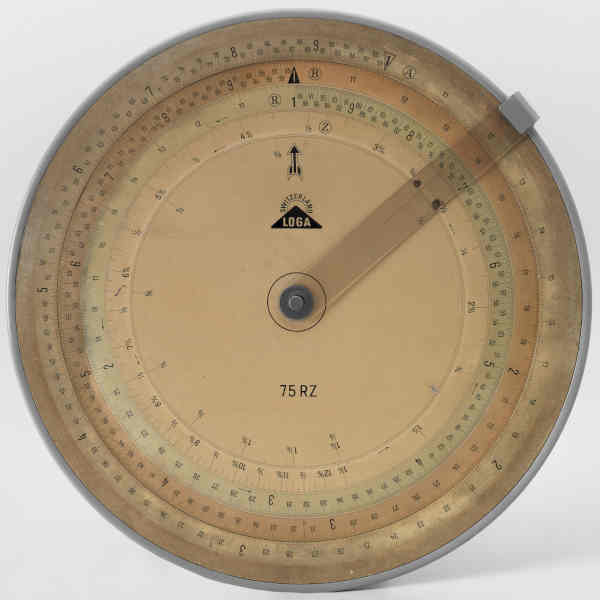
The circular slide rule is an analog calculating device invented in the U.K. in the 17th century. It was widely used until the 1970s.
These step-by-step instructions were derived from the Loga Model 30 Th circular slide rule (see Fig. 1). The inner circular scales and the pointer (cursor, runner) can be rotated in the clockwise or the counterclockwise direction, and the outer scales are fixed. Thanks to the circular form, the beginning and end of the scales coincide, and the scales are endless. This Loga instrument has (apart from the edge) a diameter of 12 cm. The main scales have a diameter of 9.5 cm. The handy circular slide rule therefore corresponds to a linear slide rule with a length of nearly 30 cm (perimeter = diameter × π; circle constant π or Ludolph’s constant = 3.14159…).

Circular slide rules have longer scales than linear slide rules and therefore are more accurate.
They have an ideal design, and their scales are endless, so the shifting required with linear slide rules
and overlapping scales,as with cylindrical slide rules, are no longer necessary.
Credit: Schweizerisches Landesmuseum, Zurich 2020
The slide rule has the following scales from the outside to the inside:
- Outer ring: first square root range (square root of x, range of values: 1–3.16), second square root range (square root of 10x, range of values: 3.16–10), basic A (x) scale.
- Inner ring: basic B (x) scale, reciprocal R (1/x), cube (x3), and logarithm (log2 x, logarithm of x to the base 2).
The same scales are on the front side of the Model 30 Tt, but this model also has additional (fixed) scales on the reverse side (e.g., sine and tangent trigonometric functions and Euler’s number), with increasing values in the counterclockwise direction.
Operating Instructions
Multiplication: 2 × 3 = 6
1. Move the beginning (the number 1) on the movable scale (inner circular scale) under the number 2 (multiplicand, first factor) on the fixed scale (outer circular scale).
2. Rotate the pointer to the number 3 (multiplier, second factor) on the movable scale, and read off the result (6) on the fixed scale.
Multiplication: 4 × 5 = 20
1. Move the beginning (the number 1) on the movable scale (inner circular scale) under the number 4 on the fixed scale (outer circular scale).
2. Rotate the pointer to the number 5 on the movable scale, and read off the result (2, i.e., 20) on the fixed scale.
Division: 9/2 = 4.5
1. Move the number 2 (divisor) on the movable scale (inner circular scale) under the number 9 (dividend) on the fixed scale (outer circular scale).
2. Rotate the pointer to the beginning (the number 1) on the movable scale, and read off the result (4.5) on the fixed scale.
Division: 56/7 = 8
1. Move the number 7 (divisor) on the movable scale (inner circular scale) under the number 5.6 (dividend) on the fixed scale (outer circular scale).
2. Rotate the pointer to the beginning (the number 1) on the movable scale, and read off the result (8) on the fixed scale.
Source
Bruderer, Herbert: Milestones in Analog and Digital Computing, Springer Nature Switzerland AG, Cham, 3rd edition 2020, 2 volumes, 2113 pages, 715 illustrations, 151 tables, https://www.springer.com/de/book/9783030409739 (translated by Dr. John McMinn)
Herbert Bruderer is a retired lecturer in didactics of computer science at ETH Zurich. More recently, he has been an historian of technology. bruderer@retired.ethz.ch, herbert.bruderer@bluewin.



Join the Discussion (0)
Become a Member or Sign In to Post a Comment